Our quick guide gives you an idea of where to go to find the type of climbing that suits you, whether it’s single-pitch outcrop routes or major, multi-pitch mountain routes.
Scotland has many different types of rock offering a great selection of climbing styles as well as a variety of different venues. There are many hundreds of smaller, often roadside crags for shorter routes, or, for the more ambitious there are superb, serious mountain and sea cliff routes in remote settings which involve long walk-ins over rough ground and where camping is necessary for any extended stay, as well as inaccessible islands offering sea cliff climbing.
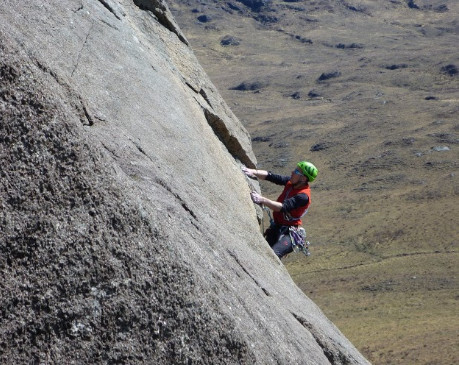
Photo by Ken Applegate
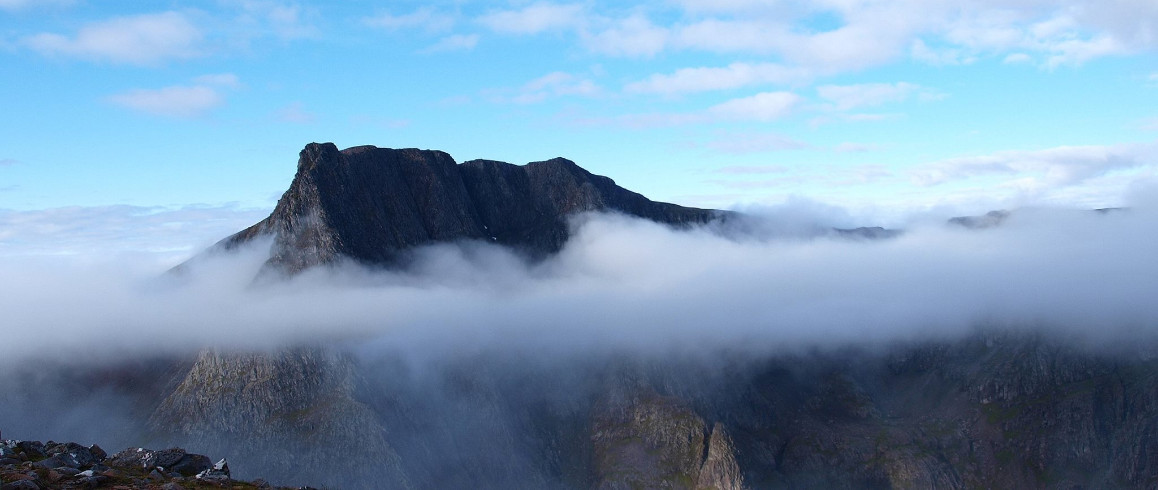
The cliffs of Ben Nevis through a cloud inversion. Photo by Brian Martin
These cliffs give the longest rock climbing routes in Scotland. Examples of some of the best would include the following:
Ben Nevis is Scotland’s highest mountain. Its northern face drops vertically over 2,000 feet (600m) in a series of complex corries, with the highest continuous wall directly under the summit. Ben Nevis is best known for its winter ice climbing but it also contains some excellent quality rock, the best buttress being Carn Dearg Buttress which is 300m high and offers a range of middle to hard grade routes. Other sections of the North Face offer 500m classic mountaineering climbs at easier grades. The rock is Rhyolite and offers fine climbing. Grades range from VD to E8 (watch this space for E13+!). Access to the climbs involves a walk of 2 hours. There is a mountaineering hut at the base of the north face that is not open to the public but can be booked for hire by MCofS members.
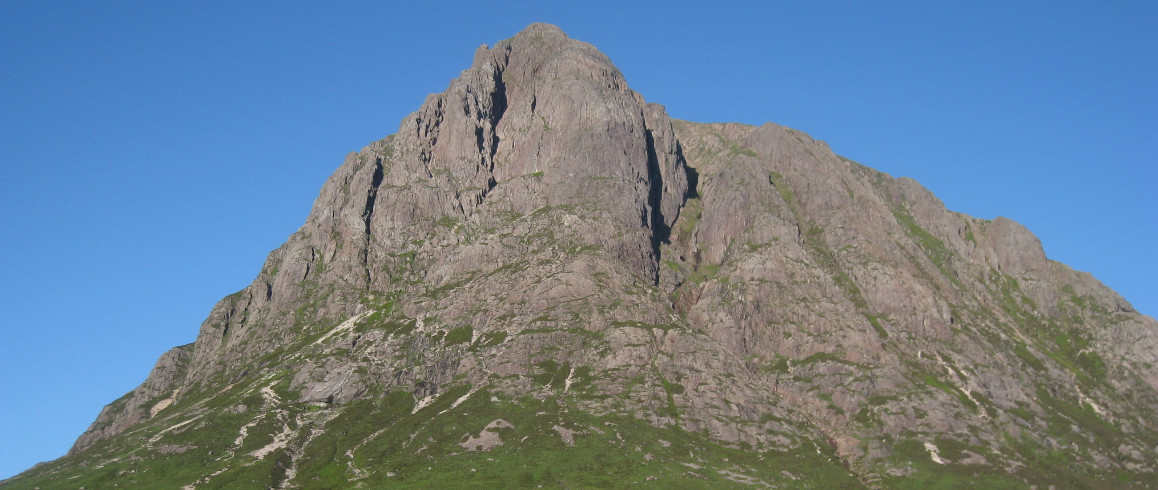
Buachaille Etive Mor. Photo by Neil Reid
Glen Coe, with the iconic Buachaille Etive Mor, is regarded by many as one of the pre-eminent climbing areas of Scotland. It has a long tradition of climbing and has been the forcing ground for many of the advances in grades over the years. The cliffs vary from 15m outcrops close to the road through the Glen, to longer mountaineering climbs up to 300m. The rock is a mixture of volcanic types with the climbs mainly confined to Rhyolite and Andesite. There are also long ridges which require scrambling and abseiling techniques (e.g. Aonach Eagach, 4km: Moderate) and there are several ‘Gully’ climbs - a particularly esoteric activity involving climbing through waterfalls (e.g. The Clachaig Gully, 500m: Severe). The majority of the climbs are on cliffs high up on the ridges of the mountains. Grades range from Moderate to E7 with the Tunnel Wall routes given sport grades of 7b – 8a.
Some of the islands off the west coast of Scotland are mountainous in character and contain large mountain cliffs:
The Island of Skye (one of the Inner Hebridean islands) contains the twin mountain chains of The Red and The Black Cuillin. The rock of the Black Cuillin is of a very rough black-coloured volcanic type called Gabbro. The routes here were pioneered from the 1890s till modern times and routes of all grades exist from Difficult to E6 up to 150m long.
In the Outer Hebridean islands of Lewis and Harris are some impressive mountain cliffs. Sron Ulladale in Harris must be one of the most impressive cliffs in Scotland with numerous routes in the upper grades of E5-E7 on it’s overhanging flanks (there is little in the way of easier routes). The routes are up to 150m in length, face west and dry quickly after rain. Creag Dubh Dibidil on Lewis gives less steep climbing on compact and often poorly protected rock but at more amenable grades on its 200m walls.
The Island of Arran. The cliffs on this island off the south west coast of Scotland not far from the city of Glasgow are composed of granite, varying in length from 90m to 300m, and mostly south or east facing. There are slabs which involve pure friction climbing such as A’Chir, Cir Mhor and Rosa Slabs as well as vertical and overhanging bastions of boiler-plate-like granite sheets such as Cioch na H’Oighe and Ceuthe Meadhonach. There are no bolts and few pegs in-situ. Grades range from VD to E6.
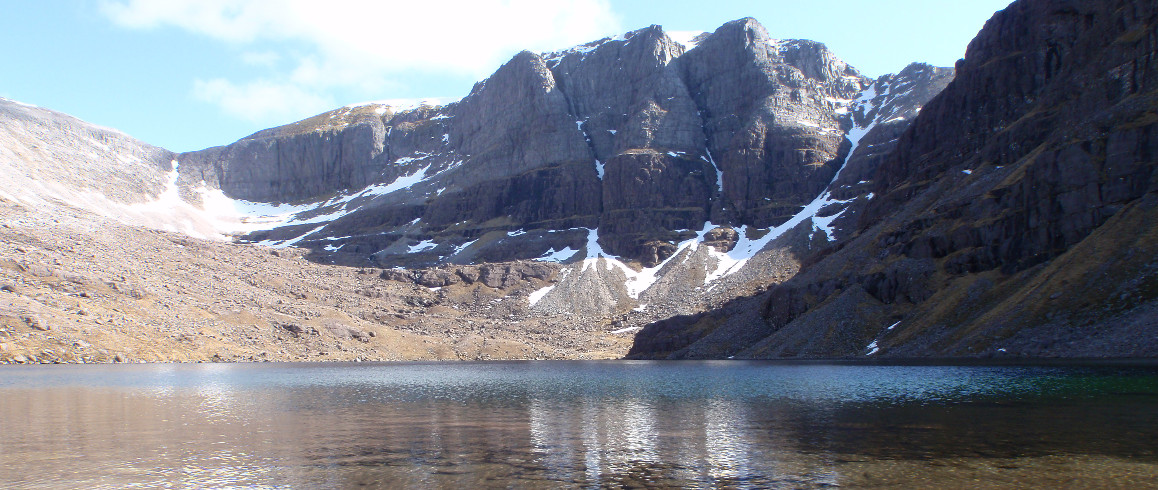
Beinn Eighe. Photo by Heather Morning
In the North West of Scotland are numerous large cliffs. Many are north facing and offer excellent winter but disappointing summer climbing. The exceptions are amongst the best and most remote cliffs in Scotland. One contender for the most remote is Lurg Mhor at the head of loch Monar. This 140m slab lies at a high altitude but is excellent quality. In the Torridon area within the ‘hidden’ Coire Mhic Fhearchair of Beinn Eighe lie the Triple Buttresses and the Far East Buttresses. The rock is excellent quartzite with a lower level of Torridonian Sandstone. The climbs are between 100m and 200m in height and routes range from Severe to E6. Further north, in the Letterewe area, is the impressive Lewisian Gneiss cliff of Carnmore. This contains routes up to 300m ranging from Severe to E6. In the extreme North West is the huge mountain mass of Foinavon. The northern side of this mountain is seamed with a line of impressive Gneiss cliffs up to 300m in height. The rock is loose in places and the northern aspect requires a settled dry spell for the crags to dry out but the brooding nature of the cliffs is impressive. There are not many routes, with the general grade being E1 and the hardest to date being E6.
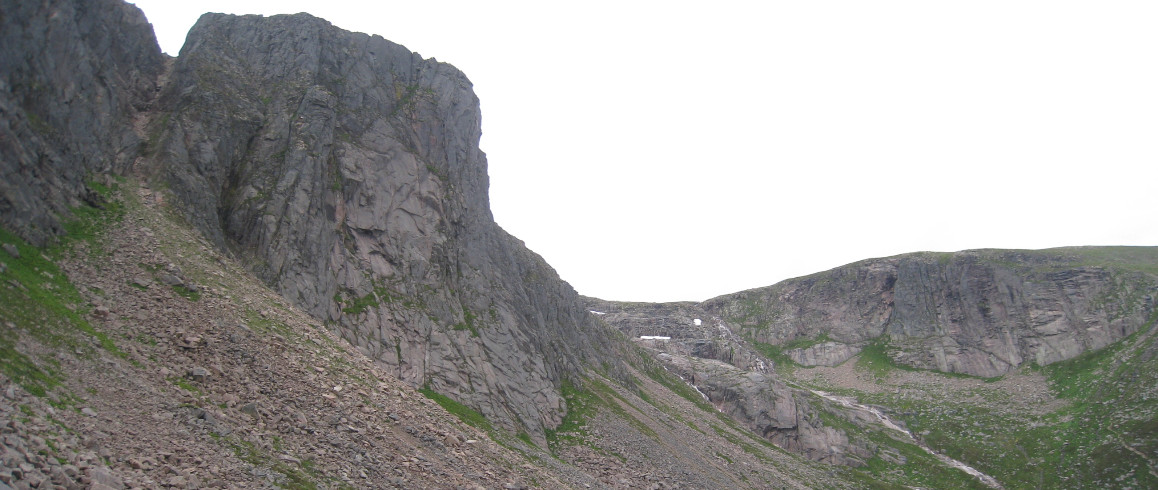
The Shelter Stone Crag and Hell's Lum. Photo by Neil Reid
The Cairngorm mountain ranges on the east side of Scotland contain large buttresses of clean granite similar to Arran. Many, unfortunately, are north facing and take time to come into dry condition after the winter. The most impressive and cleanest for rock climbing are Creag an Dubh Loch and Lochnagar in the southern Cairngorms, and The Shelterstone Crag in the northern Cairngorms. The cliffs range in size from 100m to 300m. Grades vary from VD to E7 and give some of the best mountain climbs in Scotland, particularly Creag an Dubh Loch which must be the best big mountain crag in the UK?
In the south west area of The Galloway Hills are a couple of quality mountain cliffs. The most impressive and certainly the most remote in this area is the Dungeon of Buchan. This is 130m high giving excellent climbs of HVS / E1 on perfect granite. Other smaller crags in the vicinity offer VD to E3 climbs also on granite. There is a long a tedious walk-in but the area is exceptionally beautiful and is a special conservation site (SSSI and World Heritage Site).
There are numerous small crags varying in height between 8m and 90m that are low-lying and easy of access.
In the central and lowland areas are many quarries offering interest only to local gurus but many good natural outcrops exists. Dumbarton Rock west of Glasgow offers a volcanic plug (complete with castle), 45m high with routes from VD upwards and many good boulders, unfortunately in an industrial setting. It is the unlikely home to the hardest traditional route in the world at a grade of E11- completed by Dave MacLeod in 2006. North of Glasgow lie The Whangie and Craigmore both 10-15m high basalt escarpments. A lack of protection has led to top-roping and soloing being the popular ethic. The routes are mainly in the lower and middle grades. Further north beside the village of Aberfoyle is Ben A’n, a miniature mountain, with mica schist crags up to 40m high. Grades range from Difficult to E3.
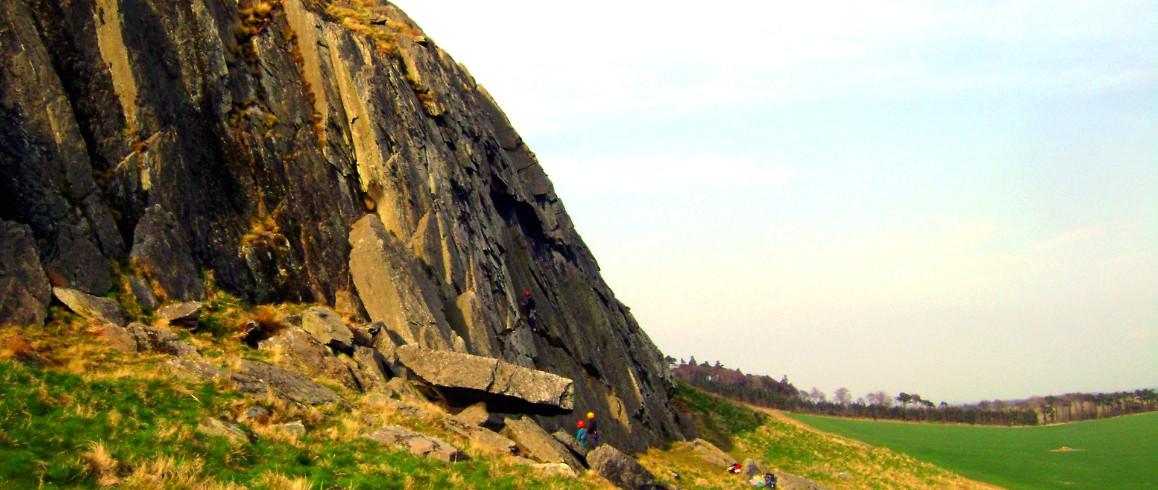
Traprain Law
On the east coast around Edinburgh can be found Traprain Law, another volcanic crag up to 20m with climbs graded Difficult to E1. Immediately south of Edinburgh lies Roslin Glen, a small valley containing a number of soft sandstone crags 15m high and offering climbs from VS to E6 – often poorly protected.
In the Central Highland area are numerous crags in several distinct main areas. In Perthshire in the centre of Scotland is Craig a Barns with several crags of schist offering slabby or overhanging climbs between Difficult and E5. Nearby is Glen Lednock with a series of crags up to 50m high and offering either schist or granite climbs from Severe to E6. To the west is Glen Nevis (beside Ben Nevis) which offers numerous climbs of up to 150m on immaculate schist, from Difficult to E9. This is probably the best easily accessible cragging area in Scotland, in one of Scotland’s most beautiful glens. Further north is Scotland’s most extensive roadside crag, Creag Dubh. This schist crag offers generally poorly protected climbs up 60m steep walls on good holds. Grades range from VS to E6 but the best routes are in the extreme grades. Also around this area are the two more remote crags of Binnien Shuas and Dirc Mhor. Both are micro-granite up to 150m high with routes up to E6. Ardverikie Wall (Severe) at the former is a classic.
In the Far Northern Highlands, the mountains tend to be separate entities standing distinct amongst vast areas of lower ground. This lower ground, although still mountainous in feel, is covered in small outcrops. Near Torridon lies Diabaig. Perfect Lewisian Gneiss up to 80m high with routes ranging from VS to E6 in one of the most beautiful settings in Scotland ensures its popularity. To the north near Gairloch are a huge number of excellent gneiss crags ranging from 9m to 90m, offering all grades of route. They all offer immaculate rock in what is frequently a rain shadow area. (Don’t always believe the weather forecast - this area is often dry when the Met Office says otherwise.) The jewels of the area are the larger crags of Creag Mhor Thollaidh and Loch Maree Crag with climbs ranging up to E6.
Beyond Ullapool lie numerous small outcrops, the most accessible being Ardmair. This 30m sandstone crag offers rounded cracks and difficult jamming with climbs up to E5 only 15 minutes from the road. Also here lies the miniature mountain of Stac Pollaidh whose western buttress is 80m high and contains some of the area’s best sandstone climbs from Difficult to E5. Other crags in this area are sea cliffs.
On the fringes of the Southern Cairngorms north of Dundee, in the Angus Glen of Glen Clova, lies a series of outcrops close to the road, but in a mountain setting. Up to six buttresses offer steep climbing from VD to E6, all facing south west. There is a bunkhouse, a Club Hut and a good café and hotel nearby –civilised mountain cragging!
The biggest sea cliffs in Scotland are found on some of the islands. Orkney and Shetland in the far north offer some of the biggest cliffs up to 350m high. On the Island of Hoy in the Orkney Islands lies the awe-inspiring St John’s Head (the biggest) and Rora Head offering Old Red Sandstone climbs, mainly in the harder E grades; while other Hoy sea cliffs such as The Berry offer the extreme end in adventurous climbing. On Orkney Mainland are smaller cliffs such as the 20m Yesnaby cliffs with their quality sandstone climbs in the mid grades. Shetland offers a veritable smorgasbord of rock types, many loose, but recent development has found gems such as Eshaness (45m) with a growing number of routes from Severe to E4.
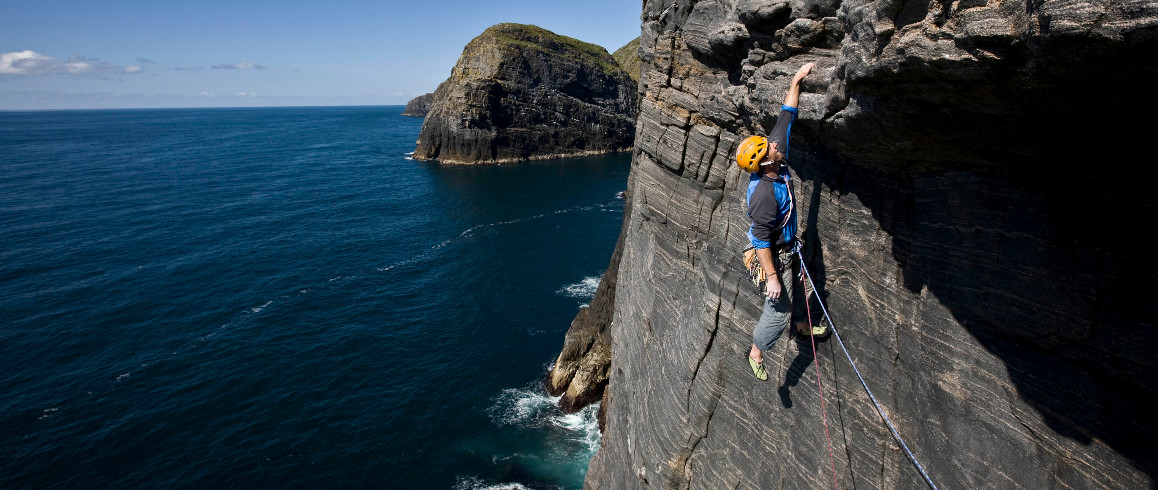
Climbing on Mingulay. Photo by Dave Pickford
The Outer Hebridean islands off the west coast of Scotland contain a wealth of immaculate Lewisian Gneiss sea cliffs. The cliffs around Uigg, and on the coastline south from here, on the Island of Lewis offer climbs up to 70m from VD to E8. At the extreme southern end of the Outer Hebridean chain (Barra Head) are the recently developed sea cliffs of the islands of Mingulay, Pabbay, Berneray and Sandray. Almost 900 climbs on perfect gneiss are found on crags from 20m to 250m in height. Despite the difficulties of getting to these uninhabited islands (a five-hour ferry and chartering a local boat) they are rapidly becoming recognised as offering the best climbing experience in Scotland.
The sea cliffs of the mainland offer venues that are generally smaller (up to 50m). They can be found all over the seaboard of Scotland. In the south west at Laggantulloch and Meikle Ross are some strange greywacke cliffs offering adventurous climbing from V Diff to E4 up to 60m. In the south east at Fastcastle near St. Abbs are slate cliffs up to 60m with steep and slab style climbs. In the north east on the cliffs between Stonehaven and Aberdeen are many cliffs around 30m in height with routes up to E6. In the Far North West around the Ullapool area are superb sandstone cliffs at Reiff, with hundreds of climbs between VDiff and E6 on a multitude of crags in small bays and headlands between 8m and 15m high. North again in the region around Tarbet and Scourie are recently developed slabs and geos of gneiss offering excellent adventurous routes in the lower grades, whilst the real gem in the extreme North West is Sheigra, offering a number of higher (50m) climbs, again on gneiss, from VD to E6. In recent years the quality of the sandstone cliffs along the east Caithness coast of the far north east towards Wick have been recognised and now there are hundreds of 25m+ routes of all grades from VD to the mid E grades; Sarclet, Mid Clyth and Latheronwheel being of particularly high quality.
Sea Stacks are a particular attraction in Scotland. These free-standing pillars, usually guarded from the mainland by a channel of sea which has to be negotiated by swimming or by boat, exist all around the country’s seaboard. The most famous is The Old Man of Hoy (100m) in The Orkney Isles whose easiest line of ascent is E1. Others include The Old Man of Storr, Am Buachaille and The Stack of Handa on the north west coast; A’Chailleach, Cape Wrath, The Maiden and Clett Rock on the north coast and The Souter in the south east. There is a website containing a guidebook to the sea stacks of the UK.
The majority are concentrated on the outcrops around the central section of Scotland, although a growing number are being developed in the West and the North West. They are found on old quarries as well as on natural outcrops in the foothills of the Highlands.
Near Edinburgh there is only one sport climbing venue - North Berwick Law Quarry. This offers 20m climbs on fine-grained volcanic rock with routes graded 6b and 6c. Around Glasgow there are a number of small quarries offering short but extremely steep and difficult sport routes, particularly at Dumbuck and Dumbarton. Grades here range from 7a to 8c.
There is a collection of quarries in the countryside around the city of Dundee which offer vertical, slabby or very overhanging climbs. They are all on sandstone and grades range from 5 to 8c, they include Balmashanna Quarry, Ley Quarry near Forfar and Legaston Quarry near Arbroath. The recently developed Rob’s Reed (near Forfar) offers the strange experience of climbing on conglomerate which sits on a sandstone base. Route grades are in the mid range and the crag is 16m high.
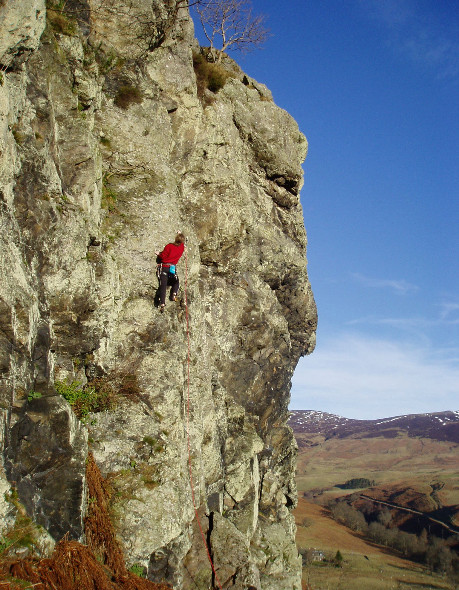
Glen Lednock sports crag. Photo by Kevin Howett
In Perthshire in the centre of Scotland and at the start of the Highlands there are many good venues. The most popular is Benny Beg near Crieff; a 10m high escarpment of Dolerite with routes from 3+ to 6a+. The crag faces south and is a sun trap in summer and winter and is often dry when all around is wet. Deeper into the hills around Comrie are two further crags: Lower Lednock in the glen of the same name is a 28m high south east facing crag with exposed routes from 5 to 6b+. Not far away from this is Dunira Sport Crag sitting high on a south facing hillside with routes mainly in the 6a to 7b+ grades. Further west of Comrie lies Lochearnhead and Glen Ogle. This small glen has become one of the most important sport climbing areas in Scotland, with over 80 routes situated either side of the road. The crags are all short (8m - 10m) but are uniformly steep and technical in character. Grades range from 5+ but are mainly in the 7a to 7c categories.
Two of the crags that make up Craig a Barns near Dunkeld contain traditional as well as sport climbs. Upper Cave Crag and Myopics Buttress give 15m overhanging routes on mica schist with grades ranging from 7b - 7c+. Further north near the small town of Aberfeldy is Weem Rock. There are five buttresses within a wooded hillside, all facing south, making excellent possibilities for winter action. The rock is excellent quality schist and grades range from 5 on the easier angled crags to 7b+ on the very steep side-walls. There is also a gear crag here offering excellent steep crack lines. Another offering in this area is a crag known as Rockdust, sitting high on a south facing hillside near Pitlochry which has great 20m lines from 5 to 7a and offers a breezy midge-free venue in the summer.
On the west, on either side of Loch Lomond, north of Glasgow, are a series of small schist crags offering a range of mostly mid-grade sport climbs. Ardvorlich (20m) has eight routes from 6a+ to 6c+.
Venturing even further west to the wild bounds of Argyll, on the Cowal Peninsular, are several superb venues. The Anvil (a giant 15m boulder) has become second only to Dumbarton Rock for hard sport routes up to 8c, whilst Tighnabruaich offers permanently dry, upside down lines around the 8a grade.
Finally in the far flung North West are a series of small Lewisian Gneiss crags around Gairloch with Grass Crag offering a spread of grades between 5a and 7a, Creag nan Luch a handful of routes from 6a+ to 7c and Am Fasgadh offering a virtually permanently dry venue and harder lines. The Aztec Tower also now sports a few low-grade sport routes on metamorphosed sandstone.
The pace of development and documenting boulder problems in Scotland since 2000 has been almost impossible to keep up with. Most of the information has only been available on the internet, but there is a guidebook being produced by Stone Country Press due in 2017.
In The City:
The undisputed ‘home’ of Scottish bouldering is Dumbarton Rock, just west of Glasgow, crouched below Dumbarton Castle. Always a forcing ground, its jumble of huge dolerite boulders continues to produce hard problems up to V15. There is much to go at here at all grades but be warned, the friction (or lack of it) on the dolerite will take some getting used to. In the centre of Edinburgh, within the historic Holyrood Park are Salisbury Crags with a whole bevy of easy to middle grade problems. And not forgetting the local forcing ground of Agassiz Rock near the Royal Observatory where hard traverses and multiple link-ups on overhanging andesite give anything up to V11.
The Central Highlands
Another single boulder that was popular since the 1960s is The Narnain Stone high on the side of The Cobbler near Loch Lomond. A handful of good problems from V1 to V5 with a good path right to the base make this popular in summer. On the opposite hill, The Brack, lies a recently developed jumble of large boulders with lines mostly V2 to V8, but beware midges and lichen. The best central Scotland venue is Glen Lednock with over 100 problems near the dam, ranging from VB (suitable for very small kids) to V9. Finally in Central Perthshire near Aberfeldy is The Chocolate Bloc in Weem woodlands, giving vertical fingery highballs from V1 –V6.
The West
In the West, the best venue has to be Glen Nevis, where there are thousands of problems recorded on numerous boulders (such as The Heather Hat Boulder) and small walls (the best being Sky Pilot). Grades range from easy (VB) to some very hard V14s. There are boulders 1 min from the road or you can explore the myriad blocks amongst the crags and woodland on either side of the Polldubh waterfall.
The North West
Where do you start? Perhaps Torridon has become most synonymous with quality Highland bouldering over the past few years with a range of amazing sandstone blocks lying on flat ground near to the road. The Celtic Jumble is only minutes from Torridon village and contains true British classics in the V3-V9 range. But the small sandstone walls and blocs have an almost never ending supply of all grades. Just to the south on the Applecross peninsular are more sandstone blocks, perhaps aesthetically more pleasing than Torridon. The Kishorn Stones lay right by the road whilst Coire nan Arr Stones are only a few minutes’ walk up the glen and together offer up to 50 problems mainly VB to V4 with the occasional test piece. Higher up one of Scotland’s famous roads, the Bealach na Ba, lie the walls and caves of The Sanctuary offering harder V4-V7 problems.
Further north towards Gairloch and Poolewe are stones galore, again on perfect sandstone, many just waiting to be discovered. However, once north of Ullapool, the locals have been busy and places to search out include the Rhue peninsula by the lighthouse with blocks and a seacliff, Ardnmair Roof, right under the road. The area around Ardmair Crag itself has numerous blocks and small walls with over 100 problems V2-V6. Then just along the road to Reiff are more great mini walls by the road brooded over by Stac Pollaidh: Reiff in the Woods has the full range of grades in a setting overlooking Loch ban a h’Achlaise. If you still have skin left on your fingers, follow the road to the end at Reiff and visit the sea cliffs of Rubha Mor for hundreds more sandstone problems.
The Far North
Less developed that the area to the south, the far north is giving up its secret boulders more slowly. The best so far are: The Rhiconich Bloodstone by the road, a giant sandstone block with 12 highball problems with classic lines at V2+; Sandwood Bay crags lying above a golden beach which although a long walk in are idyllic; and finally a collection of many blocks round the hamlet of Shiegra giving mainly V3-V5 problems.
The Islands
Most of the islands have large areas of bouldering. Skye is probably the best. In Coire Laggan in the Cuillin mountains are a dense concentration of perfect gabbro boulders. Only a short walk from a campsite and bunkhouse, but in a magnificent setting, there are problems of all grades, many highball. Also on Skye there are some impressive and loose basalt cliffs on the Trotternish peninsular although one of the cliffs, Carn Liath, gives solid rock and has a huge jumble of large boulders lying below. The landings are not quite so forgiving so a selection of matts is a good idea. On the Isle of Arran you can choose to climb next to the road or in remote mountain glens. The Corrie Boulders, some of which literally overhang the main road offer about 30 problems, mainly easy but with a few V7s. In the remote boulder fields of Glen Rosa and Coire nan Ceum in North Glen Sannox are loads of granite boulders of varying sizes and offering all grades. On the island of Mull, the best venues are Loch Bui where idyllic camping by white sands adds to the perfect gabbro and Phionnphort’s rough pink granite both of which offer problems between V1 and V6.